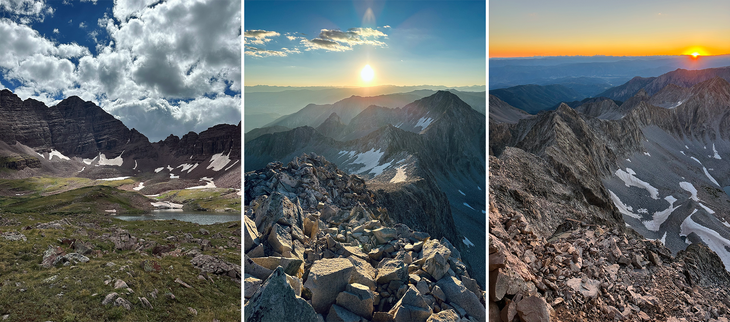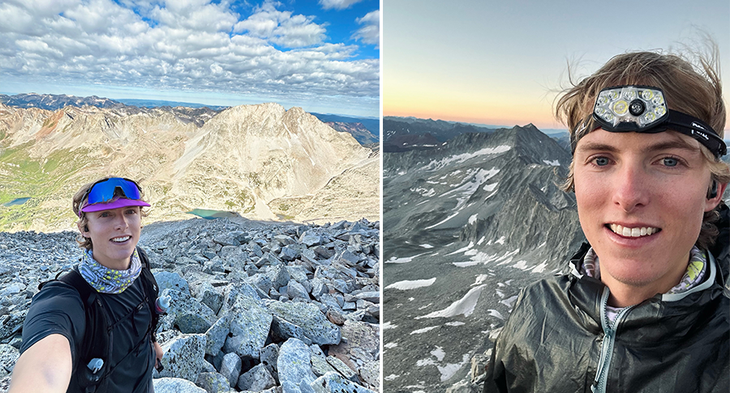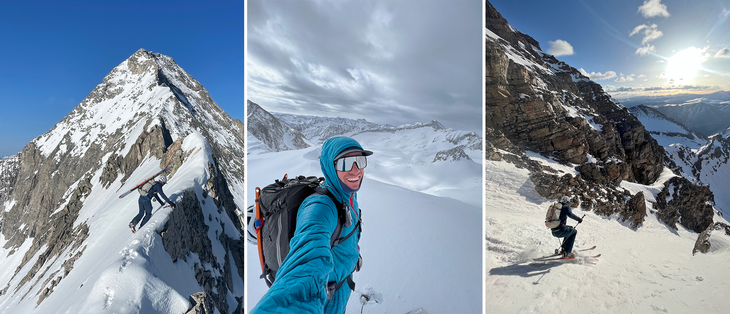Simi Hamilton Smashes Colorado’s Daunting Elks Traverse Record
This article originally appeared on Trail Runner
It’s 6 P.M. on a gorgeous summer evening in the Elk Mountains, and Simi Hamilton is perched on a ledge atop Copper Pass near 12,500 feet, taking a breather during his record-setting effort on the Elks Traverse.
The sun is starting to dip below the peaks, and a light breeze is dancing across the lush valley below. Thirty miles away, in the quaint town of Basalt, Colorado, the Olympian’s 11-month-old daughter, Lilly, is taking her first steps. It’s a great day to be Hamilton.
Elk Mountain Madness
Last week, while most of the trail running world was still focused on the UTMB events in Chamonix, France, several mountain athletes took a swing at the fastest known time (FKT) on the Elks Traverse, a treacherous route that links the seven 14,000-foot peaks in the Elk Mountain range near Aspen.
Over a span of six days, the record for this traverse fell twice. Hamilton, a three-time U.S. Olympic Nordic skier, finished the route on September 6 in an astounding time of 16 hours and 46 minutes. Just a few days prior, Chris Hopkins, another local athlete, set a time of 21:54, besting Michael Wirth’s FKT from the previous summer by 36 minutes.
“I never thought the time would drop that low,” exclaimed Rickey Gates, an elite trail runner originally from Aspen who set an FKT on the route in 2015. “Truly an Olympic-level performance by one of Aspen’s most amazing athletes. I’m very proud of Simi.”
The 36-year-old Hamilton chose to do the route unsupported. The former professional cross-country skier did this in part because of style and in part because he didn’t want to ask anyone to wait for him out in the woods.
“I mostly did it unsupported to make it so it wasn’t a pain in the ass for anyone, but also because it’s a really beautiful way to move through the mountains," Hamilton says. "I like the idea of carrying everything on my own back.”
Hopkins, 24, completed the effort in a supported style, which is how previous FKT holders have approached this line. His friend and training partner, Alex Olson, completed the traverse unsupported just a day before Hopkins started his effort. The two attempted the route together the previous summer and worked in tandem to nail down the route-finding aspects of the line, sharing route beta while working together at the Ute Mountaineer in Aspen.
The Elks Traverse spans seven 14ers--Castle Peak, Conundrum Peak, Capitol Peak, Maroon Peak, North Maroon Peak, Pyramid Peak and Snowmass Mountain--and includes considerable amounts of Class 4 scrambling and some Class 5 sections. Although it has seen only a handful of finishers, it has attracted the attention of some incredible trail running and mountaineering athletes.
“The route really captivates the mind,” Wirth, the former FKT holder from nearby Glenwood Springs, explains. “You have to go from trailhead to trailhead, but everything in between allows for a lot of artistic interpretation.”
Wirth says that the jaw-dropping views and diverse landscapes are what makes this route so unique.
“Records are great, but all of us who have attempted this route shared an experience of pushing ourselves in the mountains we love," he says. "I know both Chris and Simi hold the beauty and the challenge of these mountains dear to their heart.”

Into The Heart of Talus
The 55-mile traverse chisels a line through a range notorious for its unstable rock, temperamental weather, and deadly exposure. The route requires miles and miles of off-trail travel, often on loose terrain that threatens to swallow your tibia with one foul step. While more popular FKts, such as Nolans, include descents that are more difficult than what is typically found in a trail race, runners are rarely in danger. This is not the case for the Elks Traverse, as a significant portion of the line is on very precarious terrain, where a fall could result in serious bodily harm, or death.
There’s trail running, and then there’s mountain running. What can get lost when simply looking at a map of a route is how difficult it is to move through a particular section of terrain. The Elks Traverse forces athletes to try and move quickly through an endless landscape of wild, loose choss.
“A lot of people are fast--but being fast on that stuff is very unique,” says Ben Koons, Hamilton’s training partner, who has attempted the route himself. “The mental concentration that it takes to do that is really really difficult.”
The Jack-of-All-Trades
Simi Hamilton is probably better than you at your favorite mountain sport. It’s a fact that his wife Sophie Hamilton is very aware of. “Everything comes so easy to him--he has this unique combination of genetics and experience that allows him to excel at basically every mountain sport. But I can beat him at tennis.”
Koons, also a former Olympic Nordic skier who hails from New Zealand, agrees with Sophie’s assessment and notes that Hamilton has wanted to complete this traverse for a while, but not necessarily on foot.
“Simi has looked forward to skiing the route more than running it," Koons says. "Simi is not a runner. Obviously, he’s pretty good at it, but if you categorized him, it wouldn’t be as a runner. He’s a very talented mountain biker and certainly an amazing skier, but I don’t think that he would ever refer to himself as a runner.”
Hamilton says that he had to focus on his other skill sets to move through the range quickly.
“I don’t consider myself a great pure runner. I just don’t do it enough," he says. "I knew my strengths would be on the technical aspects, so I focused on moving quickly in that terrain. I really tried to flow through the alpine and just did the best I could on the runnable parts.”
Olympic Dreams
Hamilton is one of the most decorated Nordic skiers in U.S. history. In 2013, the Aspen native became the first American male to win a World Cup event since Bill Koch in 1983. While he competed in a variety of races on the circuit, he specialized in sprint events, high-intensity races that typically last between four and eight minutes.
Hamilton’s parents were both elite athletes. His father, Skip Hamilton, won the inaugural Leadville 100 in 1983, and his mother, Ruthie, competed in cross-country skiing events. The couple imparted their love for the outdoors to their children.
“Our days were filled with anything and everything that you can do in the mountains,” Hamilton says. “From rock climbing and mountain biking to whitewater kayaking and skiing, we did it all. I never watched TV, I was just out doing cool stuff with my family. I think that gave me the foundation I needed to become a well-rounded athlete."
Hamilton committed to ski racing at a young age. At times, it was difficult for him to focus only on skiing, as there were so many athletic pursuits that he was interested in.
“When Simi was racing, he was limited by the structure and the training plan,” Sophie Hamilton explains. “What he’s always loved to do is go on these huge adventures, and in a way, it was a relief to be done ski racing.”
Many elite ski racers are ready to be done competing because they no longer have a passion for the sport. For Simi, it was because he was craving the freedom to pursue his other interests.
“The mountains are 100 percent his happy place, and he has this gift of knowing them so well,” Sophie says. “I know that these challenges just light him up. He would say that he was meant to do big adventures like this.”
While Hamilton acknowledges that he has eclectic tastes when it comes to his athletic pursuits, he has no regrets about his skiing career.
“I really chose to make a life out of ski racing, and I’m grateful for the opportunities that I had," he says. "I’ve had so many good things come out of my life as a skier. It’s how I met my wife, Sophie, and I made so many fantastic friends along the way. Now that I’m retired, I can tackle all of these other things that I’m interested in, whether it’s the Elks Traverse or the Leadville 100 mountain bike race. I get to explore these races and routes that I have never done before.”
The Phenom
A two-time U.S. Olympic Nordic skier in her own right, Sophie is no stranger to elite athletics. Still, she acknowledges that her husband is different.
“His coordination and his comfort in sketchy situations is other-worldly,” Sophie tells me. “It can be tough for me to see him do this stuff because his baseline for what is safe is just different. But I know that he feels so in control and comfortable in this terrain that it makes it different for him. I feel a bit odd saying this--but it’s almost like watching Alex Honnold being calm while soloing El Cap. Simi’s heart rate doesn’t get elevated when he’s dancing across a technical ridge line. It’s natural for him.”
Hamilton’s ability to navigate this terrain might have something to do with how well he can control his body on the snow. The Olympian has the unique skill of being able to ski downhill on his skate skis faster than most expert-level alpine skiers, hitting speeds of nearly 60 miles per hour on what many would call death sticks. Sophie assures me her husband’s downhill Nordic skills are not normal on the World Cup circuit. “Very few cross-country skiers can, or would, do that,” she says.
Shortening the Course
Both Hamilton and Hopkins took different lines than many of the previous finishers, cutting nearly 4.5 miles of distance off the route that Wirth took. The two athletes spent a lot of time scouting the route, allowing them to identify the quickest way between the peaks. Hamilton grew up in these mountains and now works as a guide with Aspen Expeditions, giving him ample opportunity to scope the terrain. Additionally, the Aspen native has a real penchant for maps. “A lot of people spend free time scrolling social media,” Sophie says. “Simi spends his free time scrolling Google Earth.” Although Hopkins climbed his first 14er just three summers ago, he is a quick study and dedicated an entire season to learning the intricacies of the route.
Previous FKT holders, including Wirth, chose to ascend and descend the standard route on Pyramid Peak, avoiding the deadly terrain on the peak’s northeast face, which descends directly into the Conundrum valley, but adding on several miles of trail. Hopkins and Hamilton used a route they refer to as the "Banana Line," a steep descent that contours between a series of cliff bands.

“It’s a dream line in the winter,” Hopkins says. “But in the summer, it’s not as much fun. There’s a lot of butt-scooting and navigating through big rocks that like to move.”
Hamilton had scouted a different line off the peak but chose to use Hopkins' route during his effort. “I had looked at a different route that drops directly off the saddle, but it was super sketchy,” notes Hamilton. “I saw that Chris took this line, which had much less of a sketch factor, and it was just a little longer than the other one. I was pretty happy because it allowed me to avoid this really nasty zone. I wouldn’t say that this is a super fun way to go. It’s fast, but I’m not going to be up there every day going up and down it.”
Teamwork Makes The Dream Work
While FKTs are often a rather solitary affair, Hopkins and Olson approached their effort differently, using teamwork to increase their chances of sending a successful and speedy traverse.
“Alex and I had different days off at the Ute,” Hopkins notes. “We would each go scout a section on our weekends and then compare our notes to find the best way to navigate a particular section of terrain.” Both athletes love studying maps and were able to feed off of each other’s strengths to improve their skills in the mountains.
“I come from more of a running and climbing background,” Olson explains. “Chris grew up in these mountains and is more of a skier. We both love drawing lines through expansive landscapes and are able to play off of our skill sets to find the perfect route.”
“Teamwork is what sets these two apart,” notes Helen Petty, who managed the Ute when Hopkins and Olson both worked there. “They are both talented and unique athletes on their own, but together they are something special. Both care a ton about the community and work to get others involved in these sports, something that seems rare these days in this scene.”
While Hopkins’ record was broken by Hamilton just six days after he set it, the young athlete had nothing but praise for the former World Cup winner. “I’ve been fired up since watching Simi near his completion. It has been so beyond words to see the rapid progression of this route in just a few weeks time.”
Hopkins is already onto the next adventure, looking for more lines that inspire him to keep moving. “The mountains are here to challenge your own thinking and offer a path towards growth. I believe that by finding your objectives, you can learn to have a deeper appreciation for alpine environments, and yourself.”

The Kids Are Alright
Hamilton was inspired by Hopkins’ and Olson’s efforts and thinks that the youth in the Roaring Fork Valley have a bright future ahead.
“There is this awesome demographic of young kids in the valley that are sending everything,” Hamilton says. “Athletes like Wirth and Hopkins are just crushers, and I’m excited to see what they can do in the future. I think that they are really appreciating the hard work that it takes to be an elite mountain athlete.”
The former ski racer is excited for the adventure yet to come and looks forward to exploring these mountains with both his daughter and the next generation of runners and skiers.
“Hopefully, I’m not getting so old so fast that it won’t be cool to get out with me," he says. "I’d love to have the younger kids drag me out for some of this stuff. It would be great to have the opportunity to pass some of my knowledge down to them.”
As for whether or not this route can go faster, Hamilton thinks there is still room for improvement.
“My record will for sure get broken at some point. It’ll take someone who is comfortable in technical terrain, but more of a runner. I hope my effort will inspire people to get out there and do it faster than I did.”
Hamilton didn’t have much time to recover. Two days after his record-setting effort, he was back up on South Maroon, guiding a client to their own summit. Though he was tired, he didn’t bemoan the trip. There is nowhere else that he would rather be.
For exclusive access to all of our fitness, gear, adventure, and travel stories, plus discounts on trips, events, and gear, sign up for Outside+ today.

